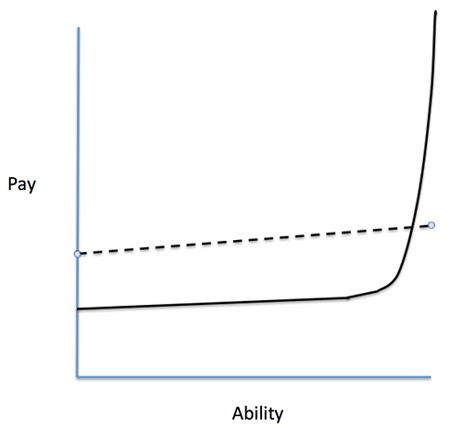
The Certainty Equivalent
-
 Jared Dillian
Jared Dillian
- |
- September 10, 2015
- |
- Comments
He knows I have military experience, and he wanted to pick my brain about how he could use his MBA while working for the government.
“Uh, you can’t, really,” I said.
So he asks me, “Should I stay in the government or get out?”
At this point I drew him a graph.

The x-axis is your ability, competence, IQ, whatever. The y-axis is how much you get paid.
So the government path is indicated by the dashed line. If you’re very smart, you can get paid a little more, but generally everyone gets paid the same no matter how competent or incompetent they are. That’s the government.
But it’s a lot more than what you would get paid in the private sector—unless, unless you are one of those savants like Zuckerberg or the Google guys or even a smart businessman or talented trader, in which case you can make a lot more in the private sector than working for the government.
But for 9 out of 10 people, no, you should not work in the private sector. You should work for the government.
So I asked him, “Are you one out of those 10 people?”
He said, “I think I am going to keep working for the government.”
Decision Theory
If you’ve ever taken a decision theory class (I have, and it was awesome), this is the first thing you learn.
You have a 50/50 chance of winning $10,000. You have P = 0.5 of getting $10,000 and P = 0.5 of getting 0.
Or you can choose not to play the game and get $3,000.
What do you do?
The answer is: it depends on who you are and what your risk preferences are.
Like what you're reading?
Get this free newsletter in your inbox every Thursday! Read our privacy policy here.
Anyone who accepts less than $5,000 to walk away is known as risk-averse.
Loss Aversion
Here is where things get interesting. Turn the experiment on its head.
Tell people they have a 50/50 chance of either losing $10,000 or breaking even.
Then tell them that they could either take their chances with the 50/50 game or they could lose a certain $2,000.
Faced with this choice, people will roll the dice. Every. Single. Time.
Nobody wants to “lock in” a certain loss. As long as there is a chance that they could break even, they will hope—except hope is not a strategy.
This is known as loss aversion.
If you understand this experiment, you understand half of behavioral finance.
Kahneman and Tversky, and Thaler
I started reading about this in 2004. Daniel Kahneman is quite famous, with his book Thinking Fast and Slow, and Richard Thaler is perhaps even more famous, with his books Nudge and Misbehaving. He is also an advisor to President Obama.
About 11 years ago, nobody outside of geeky financial circles had ever heard of these guys. I was reading their academic papers to get better at my job.
Pretty much all of the behavior of the financial markets can be explained through this framework. Particularly this correction.
This is why markets go up on an escalator and down on an elevator. People are taking tiny profits all the way up and letting the losses run on the way down.
I’m being serious.
Human beings are just not wired for risk. Both parts of the experiment are stupid. The first part is known as “taking profits too soon.” The second part is “letting losses run.”
People are guilty of both.
Trading 101
Like what you're reading?
Get this free newsletter in your inbox every Thursday! Read our privacy policy here.
Let’s talk first about letting losses run. This is the mistake beginners make.
I buy a stock at $50.
It goes to $48. No big deal.
It goes to $46.
I could have sold it at $48. I can’t sell it at $46.
It crashes to $40. Now I’m really in trouble. If I sell now, it would be catastrophic. I hope, pray, do rain dances that it will come back.
And then it goes to $20.
The professional sells when it goes to $48.
But the professional makes a different sort of error. He buys Apple at $10, sells it at $11, and then it goes to $700.
In many ways, this is much more catastrophic. Markets do go up over time, and frequently, beginning traders will get bailed out.
But you can’t undo buying AAPL at $10 and selling it at $11.
The best investors in the world don’t make any of these errors. My favorite, Stan Druckenmiller, talks about being a pig in the trade. He’d rather make a Type I error than a Type II error. Find his speech at the Lost Tree Club on the Internet for more details.
Sometimes I see beginners falling ass-backwards into great trades just because they never make the Type II error. Someone told me recently that he’s been long GOOGL since $250.
Nice job!
“But I was way too small,” he said.
Like what you're reading?
Get this free newsletter in your inbox every Thursday! Read our privacy policy here.
Tune in next time, for Trading 201.
Before I go, let me briefly tell you about a new documentary that may interest you. It’s called China on the Edge. It’s about China’s big boom, the transformation it’s in right now, and Xi Jinping’s plans for the New Silk Road that could really hurt US companies. Some big names in there too, like Ian Bremmer and George Friedman.
After seeing how the Chinese stock market crash made stocks worldwide tumble, I think you can’t know too much about China. Pre-register here to watch the film for free when it’s released on September 23.
subscribers@mauldineconomics.com

 Jared Dillian
Jared Dillian